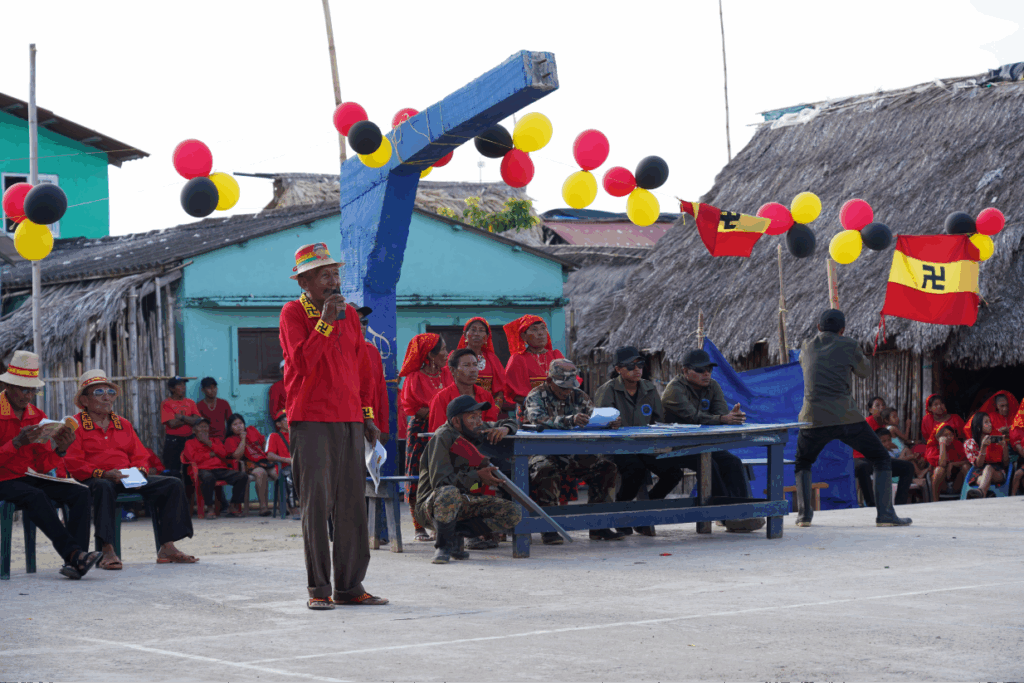May 15, 2025
Author: Jessika García
Editor: Paula Alvarado
Guna Yala, Panama – February 2025 (This article was originally written in Spanish and was later translated using artificial intelligence.)
One hundred years ago, in 1925, the Guna People of the Panamanian Caribbean led a historic revolution in defense of their autonomy, culture, and collective rights. In a context of repressive and assimilationist policies by the Panamanian State, the Guna People rose up in one of the first Indigenous demonstrations of self-determination in Latin America.
A century after that uprising, the Guna People have not only consolidated a self-governance structure recognized by Panamanian law, but have also become a regional symbol of territorial resistance. The recent commemoration of the revolution’s centennial was a profound exercise in memory, cultural reaffirmation, and generational empowerment, with Guna youth taking a central role as heirs to this legacy.
A Revolution Among Islands
The Guna territory, known as the Guna Yala Comarca, is made up of more than 350 islands and includes mainland areas as well. Despite its geography being dispersed across the Atlantic Ocean, in 1925 Guna leaders organized a decisive rebellion against state threats. As a result, the then-called San Blas Reserve—now the Guna Yala Comarca—was established, and the Panamanian State began to recognize Indigenous territorial rights.
The centennial celebration was more than just symbolic. Every year, particularly during this anniversary, Guna children, youth, adults, and elders participate in dramatizations of the historical events, reenacting the struggle for territorial autonomy as a pedagogical strategy and a means of transmitting ancestral knowledge. These cultural acts keep historical memory alive as a form of resistance against external threats and the erosion of identity.
A Model of Indigenous Self-Government
Today, the Guna Yala Comarca has its own self-governance structure, divided into two main authorities: the Onmaggeddummad Sunmaggaled (General Guna Congress), which handles political and administrative functions, and the Onmaggeddummad Namaggaled (General Congress of Guna Culture), which promotes cultural expression, spirituality, and historical-cultural heritage.
Both entities work together to defend the territory and cultivate a collective identity. For Guna elders, passing down knowledge to new generations is vital. “Ancestral knowledge is not just historical heritage—it is also a tool for struggle and empowerment to secure the autonomy and self-determination of the Guna people,” they affirm.
Youth Facing Present-Day Challenges
Currently, the Guna Yala Comarca faces critical challenges, which include population growth on the islands, the impacts of climate change, pressure from extractive industries, and social changes. These threaten both the autonomy and survival of the Guna People. In 2024, around 300 families from the island of Gardi Sugdub were relocated to the mainland due to overcrowding and rising sea levels, becoming Panama’s first officially recognized climate-displaced people.
In response, Indigenous leadership has highlighted the key role of youth. “With the overpopulation, we can no longer build more houses, and families keep growing. Faced with this challenge, our current goal is to develop the Guna Territorial Planning Plan, and the involvement of youth is crucial in this effort,” stated Adriano Pérez, General Chief of the Comarca.
For the past eight years, the Guna Youth Congress has been formally recognized as part of the General Congress, becoming a space where young people, including girls and boys, build leadership skills and work on issues such as community leadership, food sovereignty, women’s empowerment, climate change, and more. This process has enabled youth to actively participate in decision-making spaces.
Institutional changes also reflect this inclusion: “Before, the General Congress of Guna Culture was made up of five elder men. Now, it consists of five people, among whom there must be women and a youth representative,” explained the General Chief.
A New Revolution
The centennial was seen as an opportunity to renew the new generations’ commitment to the historical cause of the people. “The centennial is an example of resistance and courage that today’s youth must take as a tool for transformation—perhaps in a different reality, but with the same youthful strength. Today we use this example to pave the way for a new revolution—a revolution in defense of our sovereignty and identity, reclaiming the great legacy of the URRIGAN (Guna warriors),” shared Arnelio Brenes, Coordinator of the Guna Youth Congress.
In this context, access to resources and direct funding for the Youth Congress’s actions is considered a priority—both in terms of organizational structure and through support from strategic allies. This would strengthen their capacities in the 49 communities of the Guna territory and ensure that the revolution’s legacy remains alive among the new generations.
“We Guna youth would like to tell the world that we still exist as Indigenous Peoples, as a people capable of defending the legacy left to us by our ancestors, even with our lives,” concluded Arnelio Brenes.
